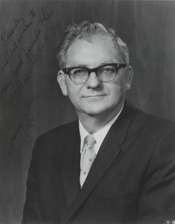E. S. Johnny Walker
| E. S. Johnny Walker | |
|---|---|
 | |
| Member of the U.S. House of Representatives from New Mexico's At-large district (Seat B) | |
|
In office January 3, 1965 – January 3, 1969 | |
| Preceded by | Joseph Montoya |
| Succeeded by | District abolished |
| 16th New Mexico Commissioner of Public Lands | |
|
In office January 1, 1961 – January 1, 1965 | |
| Preceded by | Murray E. Morgan |
| Succeeded by | Guyton B. Hays |
| 14th New Mexico Commissioner of Public Lands | |
|
In office January 1, 1953 – January 1, 1957 | |
| Preceded by | Guy Shepard |
| Succeeded by | Murray E. Morgan |
| New Mexico House of Representatives | |
|
In office 1948–1952 | |
| Personal details | |
| Born |
June 18, 1911 Fulton, Kentucky |
| Died |
October 8, 2000 (aged 89) Albuquerque, New Mexico |
| Political party | Democratic |
| Alma mater |
University of New Mexico George Washington University |
| Military service | |
| Allegiance |
|
| Service/branch |
|
| Years of service | 1942–1945 |
| Battles/wars | World War II |
E. S. Johnny Walker (June 18, 1911 – October 8, 2000) was a Democratic Politician from the U.S. State of New Mexico and a Veteran of the Second World War.
Early life
Walker was born in Fulton, Kentucky, and attended public schools there until his family moved to Albuquerque, New Mexico in 1926. He graduated from Albuquerque High School, and attended the University of New Mexico and George Washington University.
In 1942, he enlisted in the United States Army and served during the Second World War in the North African and European Theaters of operation until the end of the war. He was discharged in 1945.
Political career
Walker was elected to the New Mexico House of Representatives in 1948 from Silver City in Grant County. Walker was made Majority Whip. He served two terms, until 1952. His most notable accomplishment in the State Legislature was sponsoring legislation to allow women to serve on juries.
In 1952, he was elected as New Mexico's Commissioner of Public Lands, served two consecutive two-year terms in that office,[1] and then was made commissioner of the Bureau of Revenue for New Mexico. In 1960 he was elected NM Commissioner of Public Lands for two more consecutive two-year terms.
In 1964, he was elected to the House of Representatives by the state's voters at large to the seat previously held by Joseph Montoya, who successfully ran for the Senate that year. He served two terms in Congress, during which he was a member on the Armed Services Committee. He sponsored legislation that created Pecos National Monument.
In 1968, New Mexico drew congressional districts for the first time, and its two representatives were no longer elected at large. Walker's home was placed in New Mexico's 2nd congressional district, which included most of the southern half of the state as well as a small portion of Albuquerque. Walker had lost a lot of goodwill in this part of the state because of his support of gun control and the Pentagon's closure of Walker Air Force Base near Roswell which Walker adamantly opposed. Ed Foreman, a former congressman from Texas, ran the most expensive campaign seen in New Mexico history to that point, and defeated Walker in November 1968 by a mere half point margin.
Walker would remain minimally involved in state politics for the rest of his life, but never run for elected office again.
Walker died of leukemia in Albuquerque at the age of 89. He was cremated. Senator Jeff Bingaman honored his memory on the Senate floor.[2]
References
- ↑ State of New Mexico (July 2012). Kathryn A. Flynn, ed. 2012 Centennial Blue Book (PDF). Diana J. Duran. Office of the New Mexico Secretary of State. pp. 233–234.
- ↑ "DEATH OF E.S. JOHNNY WALKER -- (Senate - October 11, 2000)". Library of Congress Congressional Record.
External links
- United States Congress. "E. S. Johnny Walker (id: W000049)". Biographical Directory of the United States Congress.
- E. S. Johnny Walker at Find a Grave
| United States House of Representatives | ||
|---|---|---|
| Preceded by Joseph Montoya |
Member of the U.S. House of Representatives from New Mexico's at-large congressional district 1965–1969 |
Succeeded by Ed Foreman |
